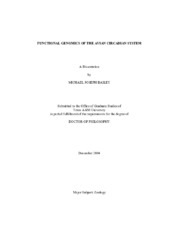| dc.description.abstract | The genetic identification of molecular mechanisms responsible for circadian rhythm generation has advanced tremendously over the past 25 years. However the molecular identities of the avian clock remain largely unexplored. The present studies seek to determine candidate clock components in the avian species Gallus domesticus. Construction and examination of the transcriptional profiles of the pineal gland and retina using DNA microarray analysis provided a clear view into the avian clock mechanism. Investigation of the pineal and retina transcriptomes determined the mRNA profiles of several thousand genes over the course of one day in LD (daily) and one day in DD (circadian) conditions. Several avian orthologs of mammalian clock genes were identified and many exhibited oscillating patterns of mRNA abundance including several of the putative avian clock genes. Comparison of the pineal transcriptional profile to that of the retina revealed several intriguing candidate genes that may function as core clock components. Including the putative avian clock genes and several others implicated in phototransduction, metabolism, and immune response.
A more detailed examination of several candidate photoisomerase/photopigment genes identified from our transcriptional profiling was conducted. These include peropsin (rrh), RGR-opsin (rgr), melanopsin (opn4) and cryptochrome 2 (cry2) genes. This analysis revealed several interesting patterns of mRNA distribution and regulation for these genes in the chick. First, the mRNA of all 4 genes is located within the Inner Nuclear Layer (INL) and Retinal Ganglion cell Layers (RGL) of the ocular retina, where circadian photoreception is present. Second, opn4 and cry2 mRNA is expressed in the photoreceptor layer of the chick retina where melatonin biosynthesis occurs. Lastly, the mRNA for all 4 candidate photopigment genes is regulated on a circadian basis in the pineal gland. As a whole these data yield significant insight into the mechanisms of the avian circadian system and present several candidate genes that may function to integrate photic information, and/or regulate circadian rhythm generation in birds. | en |


